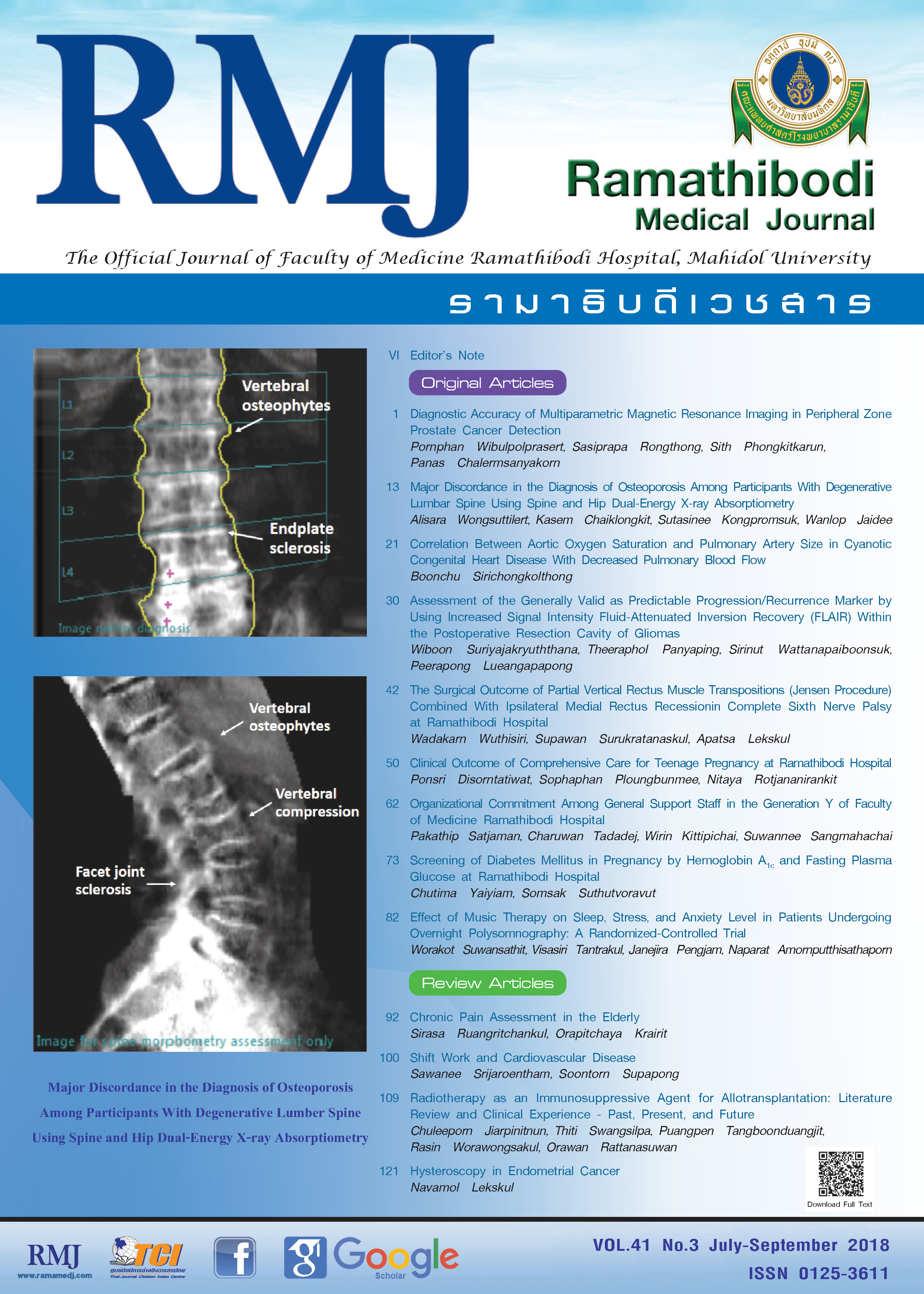Clinical Outcome of Comprehensive Care for Teenage Pregnancy at Ramathibodi Hospital
DOI:
https://doi.org/10.14456/rmj.2018.29Keywords:
Teenage pregnancy, Clinical practice guideline, ComplicationsAbstract
Background: Teenage mothers are a important health issue for public health globally. There is an increasing incidents of teenage pregnancy in many countries. Moreover teenage mothers may suffer with complications occurring both maternal and child.
Objective: To examine number of antenatal visits, complication of teenage pregnancy, with using the clinical and nursing practice guideline for comprehensive care for teenage pregnancy.
Methods: In this retrospective study, 1314 teenage mothers at Ramathibodi Hospital were included and classified into 2 groups; 656 teenage mothers from 2008 - 2011 were cared by the conventional intervention, and 658 teenage mothers from 2012 - 2015 were assigned to be cared by the clinical and nursing practice guideline for comprehensive care for teenage pregnancy. Measuring tools consisted of the clinical and nursing practice guideline for comprehensive care for teenage mothers, and checked-sheet for data collection. Data were analyzed by descriptive statistics and chi-square test.
Results: The number of antenatal visits was significantly associated with the clinical and nursing practice guideline for comprehensive care for teenage pregnancy. The complications of teenage mothers associated with this practice guideline were preterm labour, anemia, gestational diabetes mellitus, low birth weight, and small for gestational age. Pregnancy induced hypertension, preterm premature rupture of membrane, infection, post partum haemorrhage, Apgar score at five minutes stillbirth, and preterm birth were not associated with this practice guideline.
Conclusions: The results of this study support that the clinical and nursing practice guidelines for comprehensive care for teenage pregnancy is helpful for the number of antenatal visits, decrease risk of complications for teenage mothers. It should be continuity developed this guidelines.
References
World Health Organization. Adolescent Pregnancy: Issues in Adolescent Health and Development. Geneva, Switzerland: World Health Organization; 2004.
World Health Organization. Adolescent pregnancy. World Health Organization; 2017. https://www.who.int/making_pregnancy_safer/topics/adolescent_pregnancy/en/print.html. Accessed April 15, 2018.
Bureau of Reproductive Health. Health Situation in Adolescents and Youth 2015. https://rh.anamai.moph.go.th/main.php?filename=index. Accessed April 15, 2018.
Darroch JE, Singh S, Woog V, Bankole A, Ashford LS. Research Gaps in Adolescent Sexual and Reproductive Health. New York: Guttmacher Institute; 2016.
Prasitlumkum M. Risk of low birth weigth and adverse pregnancy outcomes in adolescent pregnancies at Chainat hospital. Thai J Obstet Gynaecol. 2009;17(2):93-97.
Koravisarach E, Chairaj S, Tosang K, Asavapiriyanont S, Chotigeat U. Outcome of teenage pregnancy in Rajavithi hospital. J Med Assoc Thai. 2010;93(1):1-8.
Mahavarkar SH, Madhu CK, Mule VD. A comparative studyof teenage pregnancy. J Obstet Gynaecol. 2008;28(6):604-607. doi:10.1080/01443610802281831.
Molathegi KM. Too young too know. Nursing Update. 2007:56-57.
World Health Organization. WHO guidelines on preventing early pregnancy and poor reproductive health outcomes among adolescents in developing countries. Geneva, Switzerland: World Health Organization; 2011.
Usta IM, Zoorob D, Abu-Musa A, Naassan G, Nassar AH. Obstetric outcome of teenage pregnancies compared with adult pregnancies. Acta Obstet Gynecol Scand. 2008;87(2):178-183. doi:10.1080/00016340701803282.
Tamaket N. The Situation of Teenage Pregnancy and labor in Chiangkham Hospital. Nursing Public Health and Education Journal. 2556;14(2):24-34.
Laosirirut T. Situation and trends of cesarean delivery at Nakhon Nayok hospital in the past 14 years. Thai Pharm Health Sci J. 2553;5(4):301-308.
Demirci O, Yılmaz E, Tosun O, et al. Effect of young maternal age on obstetric and perinatal outcomes: results from the Tertiary Center in Turkey. Balkan Med J. 2016;33(3):344-349. doi:10.5152/balkanmedj.2015.150364.
Sagili H, Pramya N, Prabhu K, Mascarenhas M, Reddi Rani P. Are teenage pregnancies at high risk? a comparison study in a developing country. Arch Gynecol Obstet. 2012;285(3):573-577. doi:10.1007/s00404-011-1987-6.
Medhi R, Das B, Das A, Ahmed M, Bawri S, Rai S. Adverse obstetrical and perinatal outcome in adolescent mothers associated with first birth: a hospital-based case-control study in a tertiary care hospital in North-East India. Adolesc Health Med Ther. 2016;7:37-42. doi:10.2147/AHMT.S91853.
Nair A, Devi S. Obstetric outcome of teenage pregnancy in comparison with pregnant women of 20-29 years: a retrospective study. Int J Reprod Contracept Obstet Gynecol. 2015;4:1319-1323. doi:10.18203/2320-1770.ijrcog20150703.
De Benoist B, McLean E, Egli I, Cogswell M. Worldwide prevalence of anaemia 1993-2005,WHO Global Database on Anemia. Geneva: World Health Organization; 2008:21.
Pinchaleaw D. Nurses and management of iron deficiency anemia in pregnancy women. JOPN. 2017;9(2):195-202.
Sookdee J, Wanaratwichit C. Factors affecting iron deficiency anemia among pregnant women receiving antenatal care at sub-districts health promoting hospital. Journal of Health Science Research. 2016;10(1):1-7.
Huw PJ, Karuri S, Gronin CMG, et al. Actuarial survival of a large Canadian cohort of preterm infants. BMC Pediatr. 2005;5:40. doi:10.1186/1471-2431-5-40.
Jolly MC, Sebire N, Harris J, Robinson S, Regan L. Obstetric risks of pregnancy in women less than 18 years old. Obstet Gynecol. 2000;96(6):962-966.
Cnossen JS, Vollebregt KC, de Vrieze N. et al. Accuracy of mean arterial pressure and blood pressure measurements in predicting pre-eclampsia: systematic review and meta-analysis. BMJ. 2008;336(7653):1117-1120. doi:10.1136/bmj.39540.522049.BE.
Watcharaseranee N, Pinchantra P, Piyaman S. The incidence and complications of teenage pregnancy at Chonburi Hospital. J Med Assoc Thai. 2006;89 Suppl 4:S118-S123.
Koravisarach E, Chairaj S, Tosang K, et al. Outcome of teenage pregnancy in Rajavithi hospital. J Med Assoc Thai. 2010;93(1):1-8.
ACOG Practice Bulletin. Clinical management guidelines for obstetrician-gynecologists, Number 76, October 2006: postpartum hemorrhage. Obstet Gynecol. 2006;108(4):1039-1047.

















